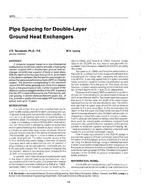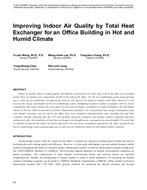This paper examines the interaction between air infil-tration/ exfiltration and conductive heat transfer in window frames. This two-dimensional conjugate heat transfer problem is solved numerically using a finite-volume method. Two window frame geometries are examined with representative infiltration air leakage rates of 1.65 and 0.55 m3/h per meter of crack length (0.3 and 0.1 ft3/min per foot of crack). For each geometry, an aluminum frame with a PVC thermal break and a PVC frame are considered. For the air infiltration case, the air-frame interaction causes the air to be preheated by the frame and decreases the apparent thermal transmittance of the frame. Conversely, air exfiltration increases the frame temperature, which increases heat losses, and the apparent thermal trans-mittance of the frame. When it is assumed that half the windows experience infiltration and the other half exfiltra-tion, results indicate that the value of ER, calculated with a proper account of the air leakage-frame interaction, could be approximately 4.0 W/m2 (1.3 Btu/h·ft2 ) higher than the ER value calculated using the current CSA procedure (CSA 1993).
Units: Dual
Citation: Symposium, ASHRAE Transactions, 1998, Vol 104, pt. 1A, San Francisco
Product Details
- Published:
- 1998
- Number of Pages:
- 9
- File Size:
- 1 file , 310 KB
- Product Code(s):
- D-7882


